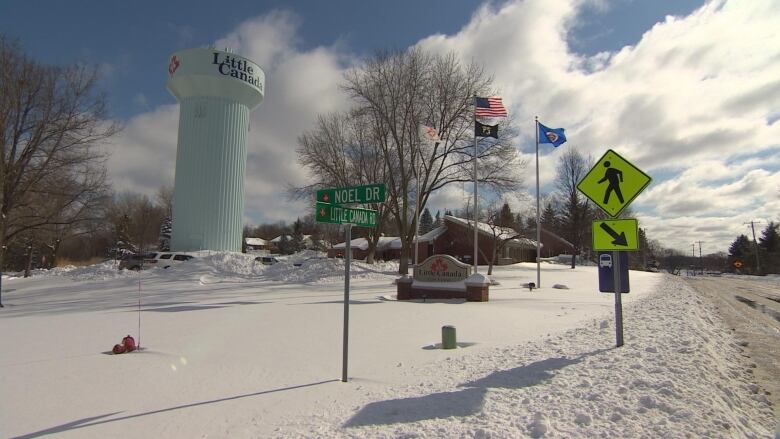Welcome to Little Canada, the Minnesota city founded by a Winnipegger who fled the floods
Minneapolis-St. Paul suburb, founded in 1844 by a Red River refugee, retains its French-Canadian roots

Nearly two centuries ago,Benjamin Gervaisdecided he'd had enough with all the flooding along the Red River, near modern-day Winnipeg.
The flood of 1826 was simply too much for a farmer born along the less volatile shoresof St. Lawrence River inQuebec. Other French-speaking farmers, some of them former voyageurs, felt precisely the same way about the Red River Settlement, the buggy and boggy agricultural community that eventually became Winnipeg.
So in 1833, Gervais packed up the family oxcart and headed south with 75 other francophones.
They became some of the first Winnipeggers to head to the U.S. in search of a better deal.
Gervais wound up settling on a bend in the Mississippi River, buying up land in modern-day St. Paul and effectively gave the Minnesota capital its name when he provided funds forthe community'sfirstCatholic church.

And in 1844, Ben Gervaisfounded a French-speaking community called Little Canada, now a city of 9,800 people entirely surrounded by the sprawl of Minneapolis-St. Paul.
"They called it Little Canada because it reminded them of home, with all the water and the trees,"said JohnKeis,the mayor of Little Canada, a municipality that continues to show off itsfrancophoneand Canadian roots.
The city's official emblem, which appears on streetsigns as well as thelocal water tower, superimposes afleur-de-lisover a maple leaf.
The August town fair is called Canadian Days. The town newsletter is called LePetitCanadien.
And the francophone-foundedcity even pulled off a political feat that ought to make it the envy of Quebec: Little Canada successfully separated from New Canada, a larger township, in 1953.
- Jets snowed under in St. Paul as Winnipeg white-knuckles its way to its first loss of the 2018 playoffs
- A Texas retiree and a Minneapolis bartender, both Jets fans, find out they are mother and son
Nonetheless, thisdistinct society within the Twin Cities isn't very French any more.
Most locals say "Jarvis" when they refer to community founder Gervaisorhis namesake Lake Gervais, the shallow body of water where Anishinaabecollected wild rice before the arrival of the French-Canadian and American settlers who would eventually possessthe land.

"This was a French-speaking community well into the 1900s," saidCurt Loschy, executive director of the Little Canada Historical Society, which possesses the family records of all voyageurs and farmers who founded the community.
Only a handful of long-time residents continue to speak a smattering of their childhood French, he said.
The Canadian content of Little Canada is also something of a coincidence. The locals are polite, but perhaps no more so than other people in the Twin Cities, who take pride in "Minnesota nice," the state-wide interpersonal esthetic.
"People are very proud of it being called Little Canada and kind of having a small-town atmosphere inside of a big town," said Mayor Keis, a retired information-technology professional who can remember the days when Little Canada was still a separate town.

Before the construction of Interstate Highway 35E, which runs north from St. Paul, "you had to pack up the family to come up here," Keis said.
The construction of the freeway may be the worst thing to ever happen to Little Canada. It was built straight through the centre of the city, effectively bisecting the 6.4-square-kilometre city into a residential eastern section and a more commercial western half.
"We always say if they had to do this over again, they probably wouldn'tdo it," said Keis of the freeway construction.
"It's a hardthing.We always try to figure out how to connect both sides, so people don'tfeel isolatedto one side or the other."
In other words, Little Canada is just likeCanada proper, where the east and west perpetually struggle to get to know each other.
- Winnipeg Jets fly back to Winnipeg after blizzard forces diversion of trip to Minneapolis
- Analysis:Rain on a wedding day? Whatever, Alanis. We have a whiteout blizzard
Despite the Interstate, Little Canada retains some semblance of its small-town feel,Keisinsisted.
"People are very proud and protective of Little Canada," he said.
"Itreallyhasn'tchanged that much," addedLoschy. "We still have the church. We still have commercialactivity, maybe more now.It'sstillagreat place to live."













_(720p).jpg)


 OFFICIAL HD MUSIC VIDEO.jpg)
.jpg)



























































































